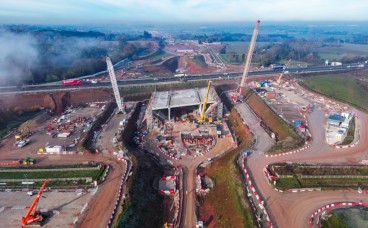How Engineers Delivered the UK’s Heaviest Bridge Slide Ahead of Schedule


Source: mediacentre.hs2.org.uk
Want to read more like this story?

Streamlining Construction: HS2 Box Structure Pushes Efficiency to New Heights
Jan, 17, 2025 | NewsThe construction of a colossal 14,500-tonne box structure to carry the HS2 rail line under the A46...

Innovative Engineering Brings Aston Church Road Bridge to Its Final Position
Aug, 16, 2024 | NewsIn a significant achievement for Birmingham's infrastructure, a new 84-metre composite bridge was s...

Britain's Longest Rail Bridge: A Historic HS2 Milestone
Sep, 05, 2024 | NewsIn a major engineering achievement, the UK’s High Speed 2 (HS2) project has set a new record with t...

1,631-Tonne HS2 Bridge Successfully Installed in Birmingham, Ahead of Schedule
Aug, 22, 2025 | NewsHS2 has achieved a significant milestone in Birmingham with the successful installation of a 1,631-...

HS2’s Stoneleigh Road Green Bridge Nears Completion, Blending Infrastructure with Nature
Feb, 14, 2025 | NewsThe HS2 project has reached another milestone with the completion of Stoneleigh Road Green Bridge,...

Connecting Communities and Nature: HS2’s Innovative Green Bridge at Turweston
Nov, 25, 2024 | NewsThe HS2 project has reached an exciting milestone with the construction of a 5,940 sq/m green bridg...

First Heavy Rail Bridge with Carbon Hangers Now in Operation at Oder River
Aug, 02, 2024 | NewsRevolutionary Engineering for a Historic Bridge Trains have made their first crossing over the wor...

From 5.5 Hours to 3: How High-Speed Rail Will Change Travel in Canada
Mar, 05, 2025 | NewsCanada is set to embark on one of its most ambitious infrastructure projects—the 1,000-kilometre hi...

Paradis Hybrid Truss With Cable Stays Bridge: Combining Strength, Sustainability, and Innovation
Dec, 02, 2024 | NewsNorway has taken a significant leap in engineering innovation with the installation of the 42-meter...
Trending

Characteristics of Load Bearing Masonry Construction

Taipei 101’s impressive tuned mass damper

Morocco Implements Landmark Dam Perforation to Combat Water Stress in Marrakech

Dutch greenhouses have revolutionized modern farming

The Line at Neom faces feasibility reassessment while construction continues

The Line at Neom faces feasibility reassessment while construction continues


